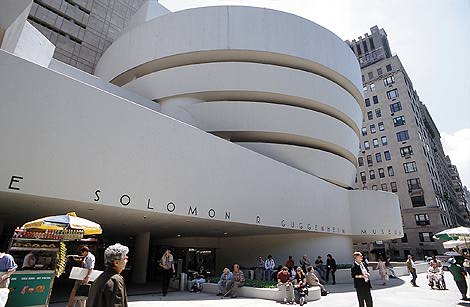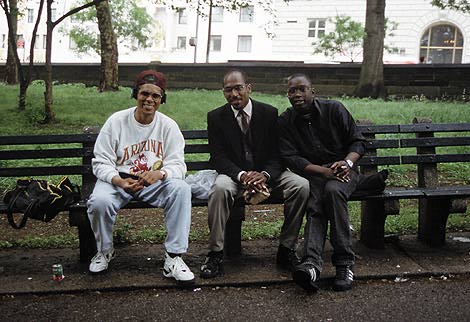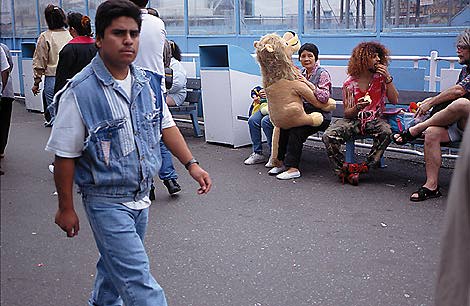
Agfa's professional slide films have, however, been renowned for their neutrality and consistent balance through the range from 50 to 200. If the new RSX 100 is a 'hotter' film, then would the 50 and 200 speed variants match it?

The Guggenheim Museum lit by reflected sun, shot with a 20mm lens, and making use of the very grain-free and smooth mid tone rendering of Agfa RSX 50
Shirley took a few rolls with her on a visit to New York, where between calling in at the Guggenheim and the International Center of Photography she was able to try all three films out in conditions which were far from perfect. The light in New York can be awful and the high canyons of buildings don't improve it; the weather was too poor for serious stock photography, and Manhattan is not a tourist showpiece.

An Englishwoman with a 13-year-old daughter wandering New York with a camera may not be the recommended way to spend a week, but wherever Shirley went - even Harlem and the Bronx - she found people friendly, ready to talk, and not threatening. This trio asked her to shoot the picture, and Agfa RSX 200 responded well to extreme contrast from the background to foreground
Prepared for this, a Minolta 7xi body with bracketing card was set to one f-stop bracketing instead of the usual half-stop. Auto bracketing was used for nearly every shot and proved essential despite the accurate matrix metering system used on this SLR. The lenses used were a 20mm f2.8, 24-50mm f4 and 70-210mm f4. The two shorter lenses were fitted with colourless UV AC filters, the longer zoom with a 1B.

Right - RSX 50's sharpness is invaluable when the shot has to contain a wealth of detail. The color balance of evening light here was not too blue in the shadows
RSX 50 is very similar in feel to the earlier emulsions of this speed, offering good latitude and tonal range combined with very accurate and pleasant overall colour balance. It is not as 'snappy' as RSX 100, and in place of high chroma it offers unrivalled visual sharpness. Fine grain and edge emphasis seem to have been the targets of Agfa's film designers here, perhaps understandable in a film chosen when conditions are ideal and slow speed is acceptable.
RSX 50 has many of the benefits of a film like Fuji Velvia in terms of grain and sharpness, without going to the same extreme in colour strength or contrast. It is not especially warm in balance and skin tones are improved by slight underexposure or sympathetic lighting and filtration.

On a Coney Island in dull weather, a 50-speed film is not ideal, especially when looking for candid shots. Slight underexposure does no harm with RSX 50, and the extra sharpness and fine grain would make it possible to enlarge just the right hand group on the bench in the background, which is the point of focus here
This is a film which rivals Kodachrome for fine-detail and sharp-edge definition when printed or projected and can posses an engraving-like quality. It is also very well suited to subjects with large areas of even or smooth tone, especially in the quarter-tone and mid-tone region where it has a distinct 'lift'. This characteristic will also made it suitable for copying maps, watercolours and similar originals.
RSX 200 is also entirely different from RSX 100, this time pitching in the direction of magenta colour and lower chroma with high contrast. In sunshine, colours do appear very saturated, but this is largely a result of inherent contrast combined with a high d-max for a film of this speed. On dull days, when the film is most likely to be used, it is very neutral and benefits from a warm-up filter.

The speed of RSX 200 combined with minus one bracketing and a minus one over-ride - a two-stop correction - helped capture this otter in the Bronx Zoo at the 210mm end of the tele zoom lens. The film's deep maximum black ensures the image retains a full tonal scale
The high maximum density is accompanied by fine grain (the two always go together) and this in turn makes the film probably the sharpest 200-speed emulsion around, subjectively. It would be hard to pick between this and Fuji Sensia 200 from an amateur viewpoint, but RSX 200 is of course a professional emulsion designed for refrigerated storage and offering repeatable colour from batch to batch if handled properly.
Latitude is not a strong point of RSX 200 and underexposure produces very dense images. The 'cool pink' balance is better than Kodak's Ektachrome 200 'golden yellow' for indoor mixed light shots, especially when fluor-escents are involved. Many interiors will require no filtration on this film if a natural effect is required.